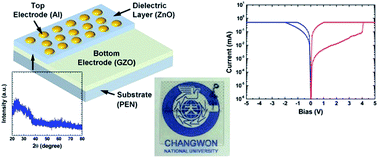Resistive switching in an amorphous ZnO dielectric film prepared on a Ga-doped ZnO transparent electrode
Abstract
The resistive switching behaviour of amorphous ZnO (a-ZnO) sandwiched between Ga-doped ZnO (GZO) transparent conductive oxide and Al electrode is reported. Transparent GZO films were deposited on polymer substrates as bottom electrodes using pulsed DC magnetron sputtering at 100 °C, on which a-ZnO films were deposited by RF magnetron sputtering at room temperature. The layered structure prepared in this manner was semi-transparent to visible light and its current–voltage hysteresis was representative of a bipolar resistive switching behaviour. The observation of such a resistive switching behaviour was attributed to the employment of a-ZnO as a dielectric layer and the use of Al and GZO as electrodes, which enabled the formation of Schottky barrier only at the a-ZnO/GZO interface. The conduction through the dielectric layer during the high resistance state was due to the Schottky emission as deduced from the consideration of band structures and the fitting of the current–voltage relations to the various conduction models. Switching to the low resistance state was attributed to the filament formation due to the migration of oxygen vacancies during the set process. In control experiments where crystalline ZnO was used as the dielectric layer, resistive switching behaviour was not observed.


 Please wait while we load your content...
Please wait while we load your content...